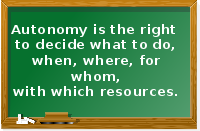Autonomy is a concept with many nuances. Here, autonomy is meant to mean: the entity itself decides what to work on, when, where, for whom and with which resources. This kind of self-governance is well-known to be very important:
- Humans: they work best when they can govern themselves, .i.e. when they can decide on their own how to prioritise their time and activities. Studies about human work practice show that autonomy is directly and positively related to performance.
- Machines: these are the hosts for many different ‘processes’ (e.g., services, agents, …). The more participants that are served by this machine, the more important is the trade-off regarding not only the management of these processes, but also within each process: what to do first, ‘whom’ to serve first?
The mechanisms by which autonomy is manifested are, of course, quite different between humans and machines. Yet, by explicitly recognising that both have autonomy it becomes simpler to analyse, design, model and realize useful solutions.
It is important to recognize that the participants that are part of your solution, are often not under your full control. Some, many or even all of the participants may reside in different organisations, have had different training, live in different countries, have different versions of software, work from different legal structures, etc. By approaching these participants while guaranteeing their autonomy, you can increase the effectiveness of finding an useful modus-operandi in your solution. This approach also compensates for the fact that participants may not always behave (respond, communicate, act, …) exactly as you expected or as they previously agreed on: When you prepare for these eventualities, your solution will become more robust and ‘fails gently’ if it needs to fail at all.





